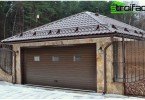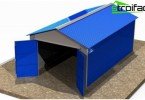Perhaps every car owner knows that damp and cold are fatal for vehicles, so it’s not enough to take care of the reliability of the garage for your beloved “iron horse”, it’s important to worry about the warming of the “car house” as well. Properly thought out thermal insulation will help to save a significant amount that will have to be spent on additional heating means in case of a careless attitude.
Content
- Vehicle Storage Standards.
- Rules for moving warm air.
- Types of thermal insulation materials
- Classic insulation – a proven way.
- Advantages of advanced thermal insulation
Vehicle Storage Standards
Some may be surprised, but there is a list of conditions necessary for a comfortable car stay in the garage. The most important are:
- the temperature in the room (throughout the entire period of cold weather) should not exceed and should not fall below the optimum limit for storing the machine +5 degrees;
- the flow of fresh air obtained through a clearly designed ventilation system should correspond to 180 m3 / hour (normal for 1 car).
Unfortunately, disregard for these important recommendations is not uncommon, because most do not consider the garage where the above temperature conditions are created to be so warm. Let’s try to figure it out. Such a low temperature is necessary to prevent condensation, which is the main cause of corrosion processes..
It is important! When creating greenhouse conditions, the car is covered with perspiration, which contributes to the appearance of foci of rust.
Speaking about ventilation, it should be noted that often inexperienced owners of cars, trying to create comfortable conditions, close ventilation holes.
This is unacceptable because ventilation is necessary to maintain an optimal microclimate, to purify carbon monoxide from the air and to prevent damping of the car.
Rules for moving warm air
Thermal insulation will help the vehicle with honor survive the season of severe frosts and get out of the “battle” with frost and snow winner. To realize such an important task, heat-insulating materials of low thermal conductivity will be needed. But before you get this or that type of insulation, it is worth remembering how the movement of warm air mass occurs in space.
- convection (continuous movement of warm air, due to which heating occurs);
- conduction (a process in which more heated areas transfer heat to less heated ones);
- thermal radiation (a procedure that proceeds with the release of heat, but without air movement).
The most effective insulation to date is the one that combines the classic version that prevents conduction and convection, and a reflective heat insulator that does not allow thermal radiation.
It is important! This type of insulation is especially good if the garage is part of a residential building. If not, then such a powerful thermal barrier is not necessary..
Types of thermal insulation materials
There are 2 types of insulation materials: classic and modern.
Classic insulation – a proven way
This type of insulation is in turn divided into:
- polymer obtained by extrusion finishing of polymers;
- mineral wool produced in the process of melting basalt;
- fiberglass that occurs after processing broken glass.
Classical heaters include:
1. Mineral wool. This material has excellent technical characteristics, but it does not tolerate moisture, so when using it, take care of vapor and waterproofing.
2. Glass wool is not only afraid of liquids, but also fire, which means it requires increased attention when using.
3. Polyfoam. Refers to polymers that are not afraid of moisture, fungi and microbes. However, the material is flammable, which indicates careful compliance with fire safety standards.
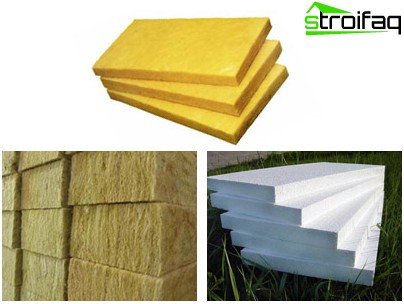
Classic insulation: fiberglass, mineral wool, polystyrene foam
You need to know! It is recommended to use PBS-S polystyrene with a flame retardant, a substance that contributes to self-extinguishing in a fire.
Advantages of advanced thermal insulation
These are new generation materials that have improved performance..
1. Penoizol – polystyrene in liquid form, which does not ignite and boasts a service life of more than 40 years. By the way, the cost of penoizol is 1.5 times lower than the cost of conventional foam.
2. Astratek is another representative of the family of liquid heaters, which is applied as a paint. A 1 mm layer replaces 50 mm mineral wool. An insulator with a flat surface is consumed at the rate of 0.5 l / 1m2.
3. Polyurethane foam will require for the application of special equipment. The even layer forms a crust that will serve as a reliable protector for at least 70 years.
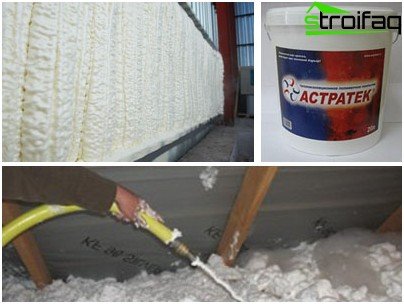
Modern heaters work great, are easily and quickly applied to the treated surface
You need to know! The most expensive classic insulation is mineral wool, and polyurethane foam will make you fork out of modern insulators.
How to insulate a metal garage: stages
Garage insulation is a multi-stage process, which, with a minimum of theoretical knowledge, can be done independently. Walls metal garage not only need to be insulated, but also protected from condensation (unnecessary moisture). If you plan to use mineral wool, then do not forget to prepare a film to cover the protective layer.
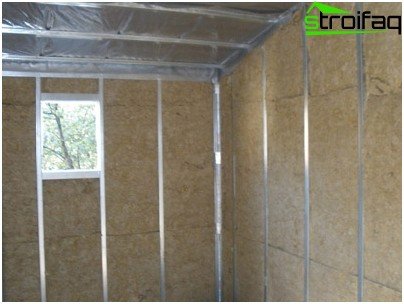
Mineral wool insulation fixed by frame construction
It is important! In order for the insulation to turn out to be really high-quality, the mineral wool and the film should be covered with a hard coating of fiberboard, gypsum fiber board or chipboard.
A less troublesome option is insulation with foam. The areas of intended application of the adhesive are thoroughly cleaned and degreased. As glue it is permissible to use bitumen mastic or liquid nails. If you put mastic on the entire wall, you can achieve good protection against moisture. The only negative is an unpleasant odor, which can be felt with poor sealing of joints. So that in hot weather the foam sheets do not peel off, the seams between them must be treated with silicone sealant. Do not use foam!
How to insulate a garage if the walls are very thin? No panic! You just have to insulate on both sides. Extremely internal warming leads to a dew point shift and condensation. As a result, we get the opposite effect. To create ideal conditions for a car, you will have to insulate all the surfaces of the structure: floor, walls, roof.
Create a warm floor
The initial stage of work, for which a timplex that can withstand temperatures from -50 to +75 degrees, is perfect. Timplex easily compresses and bends, taking any shape, and the strength indicators are quite high.
It is important! Do not forget to screed over the tymplex.
Garage wall insulation
It is better to produce with foam. Walls are cleaned of old plaster and degreased. Cracks discovered during work, it is necessary, to improve adhesion with glue, to seal and process with a primer. The glue is applied using the “blot” method, after which the sheet is pressed with force.
It is important! Glue is best applied with a notched trowel – so the risk of gaps between the surface and the foam is significantly reduced.
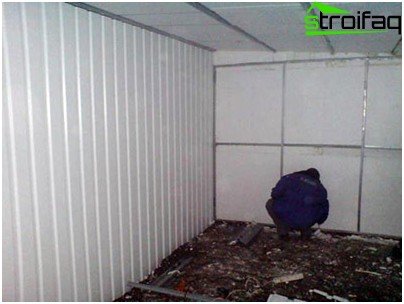
Wall insulation with foam
The sheets should be glued from bottom to top, and the very first row is laid on the starting plate, fixed to the wall surface with dowels. A mesh web is glued over the foam. Apply glue with a layer of 5 mm on the insulating material and recess the mesh. After drying the walls need to be plastered.
It is important! Facade plasters in this situation are preferable, because they are more resistant to dirt and have enhanced physicochemical properties.
External insulation is carried out according to a similar scheme, only the foam layer should not be less than 30 mm.
We eliminate heat loss through the roof
If the arch system is rafters, then rolled insulation is preferable, which are fixed based on the design features. The insulation scheme should look like this: hydrobarrier – insulation – vapor barrier.
If polystyrene is chosen for the role of insulation, then holes for the bars should not be drilled – there is more than enough glue. When using mineral wool, you need to attach it to the roof lathing in an even layer. If the arch consists of reinforced concrete slabs, then it is also necessary to insulate from the outside, for which foam sheets with a plaster screed will fit.
It is important! Do not be lazy to lay between the foam and the external plaster roofing material or roofing film.
Garage door insulation
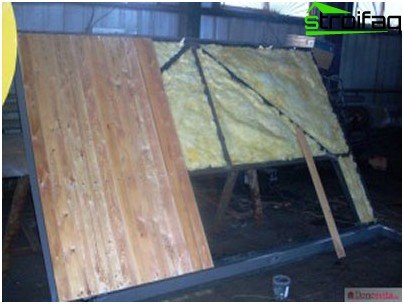
Gates – a significant structural component of the garage, insulation of the gates will significantly reduce heat leakage
To protect the metal structure, a crate is attached. Then, with any insulation, the existing gaps are filled. Make sure there are no gaps. Joints can be self-adhesive with ozolone. To give an aesthetic appearance, the gates are lined with clapboard.
How and how to insulate the cellar?
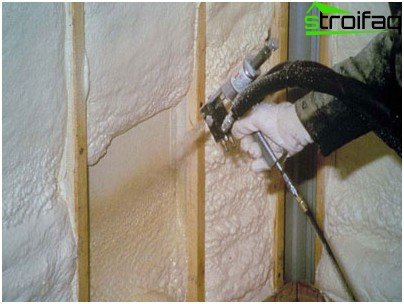
It is better to insulate the walls with expanded polystyrene
To warm the basement walls, expanded polystyrene will be the best assistant. It is important to achieve the most even surface of the walls. Antiseptic and antifungal impregnation will also come in handy. Use PSB-S-25 (at least 50 mm thick). This will help to create a stable temperature in the cellar. Carefully check the joints, this will help to avoid the appearance of cold bridges..
Now you know how to insulate the cellar in the garage and the “house for the car” in general, which means that you will be able not only to protect the car from corrosion and wear ahead of time, but also if necessary to inspect and repair it in the harsh time of the year.



